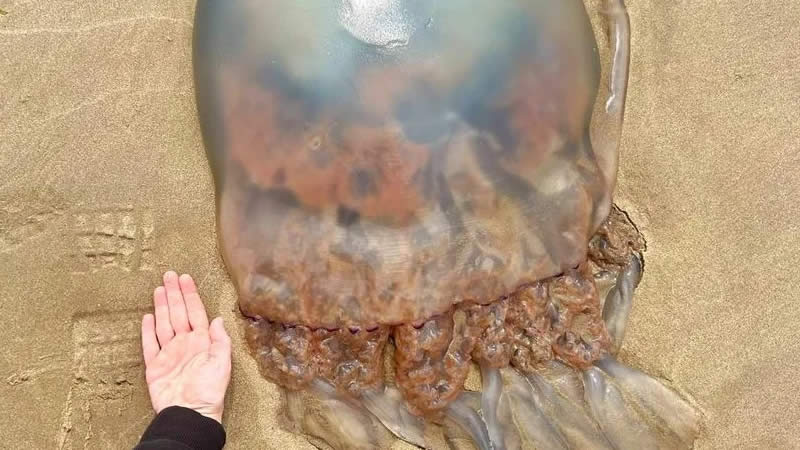
Giant Jellyfish and Spider Crab Invade Welsh Seaside
Share0The sudden appearance of gigantic jellyfish and a spider crab at a seaside resort in Wales has left beachgoers vowing to never swim in the sea again. These enormous creatures, resembling an alien invasion, startled visitors in the Barmouth area.
Holidaymaker Amy Carter shared photos taken by her partner Scott Southey on the I Love Barmouth Facebook page, sparking a mix of fear and fascination. “On my goodness!! Imagine swimming next to one that size. I’d freak! They are massive,” exclaimed one woman on social media. Another declared, “Last time I go in the sea.”
One commenter added, “Omg that is the stuff of my nightmares. That crab could wipe out a town.” However, another noted, “Seen loads on the beaches. It’s amazing what nature will show us.”

Amy told the Mirror, “We are having a short holiday this week and were just having a stroll down Tal-y-bont beach… we always see small crabs and jellyfish around the rocks and on the beach but were shocked to see any this size. I’ve been coming to Barmouth and Tal-y-bont for nearly 50 years and it’s the biggest I’ve ever seen, so I had to put my hand next to it for scale. I find it amazing to actually see the true giants of the deep.”
Another similar jellyfish was discovered on nearby Dyffryn beach by Ian Wilkins, who also shared his photo on the Facebook group. He told the Star, “I was shocked to see this jellyfish and the huge size that it was. Fascinating creatures.”
One person commented, “There were lots on the estuary yesterday! Had to get the binoculars out because I thought there was something big washed in….. they were giant barrel jellyfish. Quite harmless to people… they are HUGE this year.”
Barmouth, like many seaside towns along the coast, regularly sees its fair share of jellyfish and curious sea creatures. Frankie Hobro, director of Anglesey Sea Zoo, provided insights into these sightings. “These are both common British species. The crab is a spiny spider crab which can grow to a foot in diameter (closely related to the King Crab) and they are common all around our coasts. We have numerous spider crabs in our aquarium exhibits; they live for many years.”
“It looks as if this individual is dead, and that mussels and other marine life have taken advantage of the carcass as an anchor point,” Hobro explained. “It is equally likely that these animals were living happily on the shell of the crab while it was alive, as this is common.”
Hobro continued, “Like all crustaceans, spider crabs have to moult their outer shell to grow, so it is common to find intact crab moults along our shoreline. These can be mistaken for dead crabs. In fact, often in early summer, when mass spawning and moulting occur, thousands of spider crabs close to shore can leave beaches full of crab shells. This can appear to be a mass die-off but is actually a positive sign of the crabs growing and breeding.”
Regarding the jellyfish, Hobro said, “The jellyfish shown is a barrel jellyfish, another common British species often found around our shores in spring and early summer. It does not tolerate warmer temperatures, so it is less common in summer and early autumn when the seas are at their warmest. Although they look formidable and can grow to the size of a beer barrel, their sting is harmless to humans.”
She added, “These jellyfish are the favorite food of leatherback turtles, our only native turtle species, which is rarely sighted as it is usually found offshore. They are present for over half the year, specifically to take advantage of the large numbers of large jellyfish like these found in the sea around the UK.”
